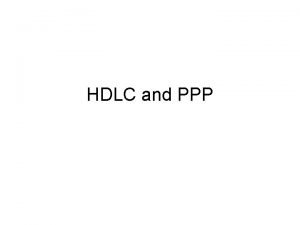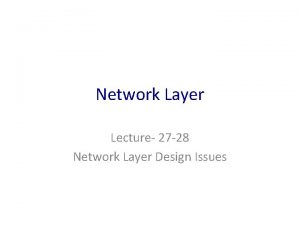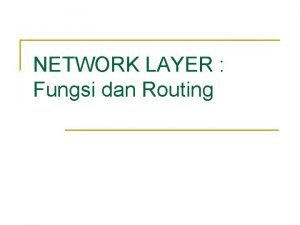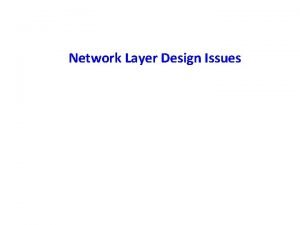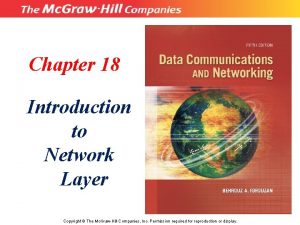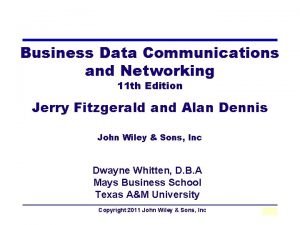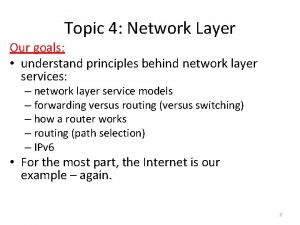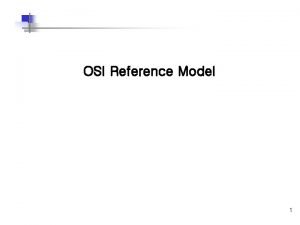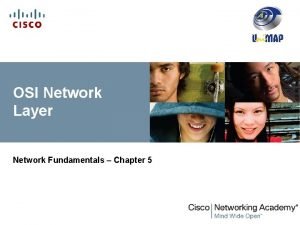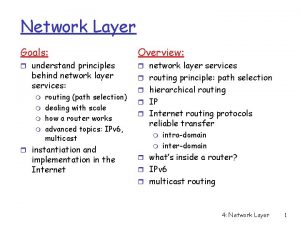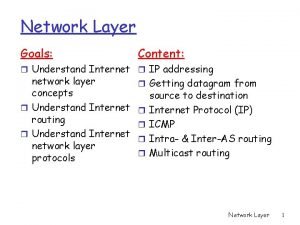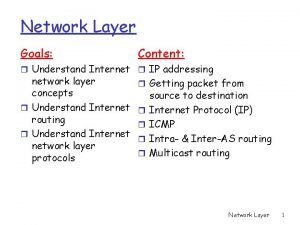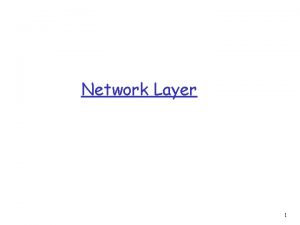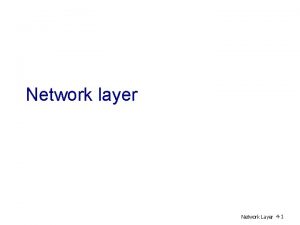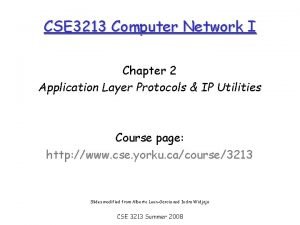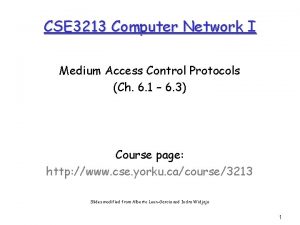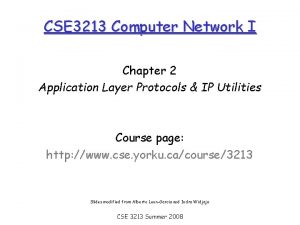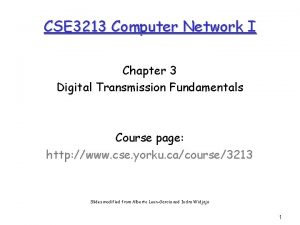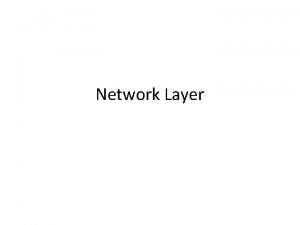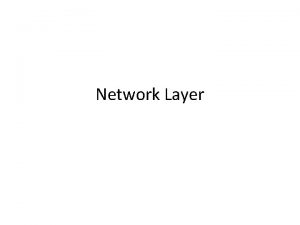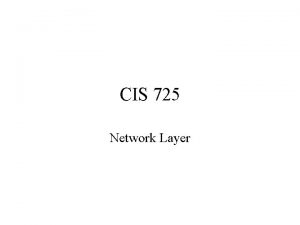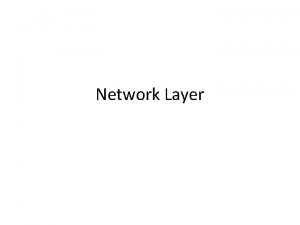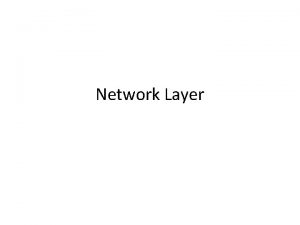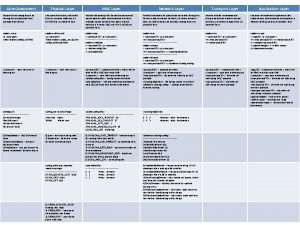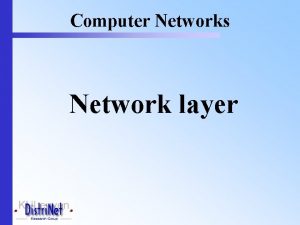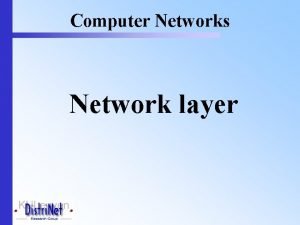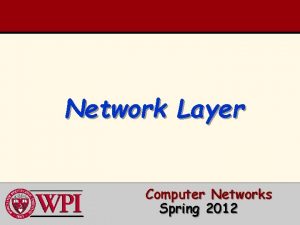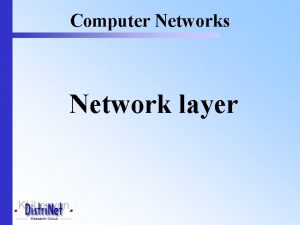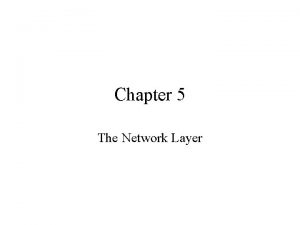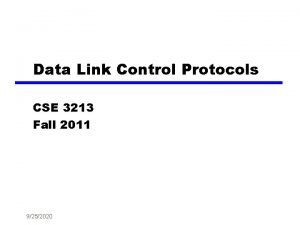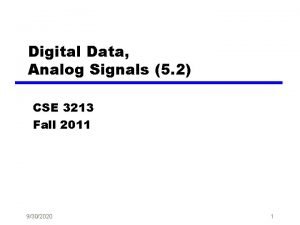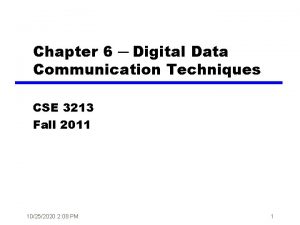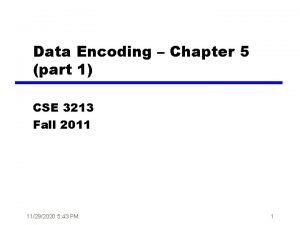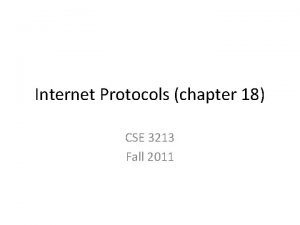CSE 3213 Computer Network I Network Layer 7































- Slides: 31

CSE 3213 Computer Network I Network Layer (7. 1, 7. 3, 8. 2. 1 -8. 2. 3) Course page: http: //www. cse. yorku. ca/course/3213 Slides modified from Alberto Leon-Garcia and Indra Widjaja and Jim Kurose 1

Network Layer • Introduction • Virtual circuit and datagram networks • IP: Internet Protocol – Datagram format – IPv 4 addressing 2

Network layer • transport segment from sending to receiving host • on sending side encapsulates segments into datagrams • on rcving side, delivers segments to transport layer • network layer protocols in every host, router • router examines header fields in all IP datagrams passing through it application transport network data link physical network data link physical network data link physical application transport network data link physical 3

Two Key Network-Layer Functions • forwarding: move packets from router’s input to appropriate router output • routing: determine route taken by packets from source to dest. analogy: • routing: process of planning trip from source to dest • forwarding: process of getting through single interchange – routing algorithms 4

Interplay between routing and forwarding routing algorithm local forwarding table header value output link 0100 0101 0111 1001 3 2 2 1 value in arriving packet’s header 0111 1 3 2 5

Connection setup • 3 rd important function in some network architectures: – ATM, frame relay, X. 25 • before datagrams flow, two end hosts and intervening routers establish virtual connection – routers get involved • network vs transport layer connection service: – network: between two hosts (may also involve intervening routers in case of VCs) – transport: between two processes 6

Network service model Q: What service model for “channel” transporting datagrams from sender to receiver? Example services for individual datagrams: • guaranteed delivery with less than 40 msec delay Example services for a flow of datagrams: • in-order datagram delivery • guaranteed minimum bandwidth to flow • restrictions on changes in interpacket spacing 7

Network Layer • • Introduction Virtual circuit and datagram networks What’s inside a router IP: Internet Protocol – Datagram format – IPv 4 addressing 8

Network layer connection and connectionless service • datagram network provides network-layer connectionless service • VC network provides network-layer connection service • analogous to the transport-layer services, but: – service: host-to-host – no choice: network provides one or the other – implementation: in network core 9

Virtual circuits “source-to-dest path behaves much like telephone circuit” – performance-wise – network actions along source-to-dest path • call setup, teardown for each call before data can flow • each packet carries VC identifier (not destination host address) • every router on source-dest path maintains “state” for each passing connection • link, router resources (bandwidth, buffers) may be allocated to VC (dedicated resources = predictable service) 10

VC implementation a VC consists of: 1. path from source to destination 2. VC numbers, one number for each link along path 3. entries in forwarding tables in routers along path • • packet belonging to VC carries VC number (rather than dest address) VC number can be changed on each link. – New VC number comes from forwarding table 11

Forwarding. VCtable number 22 12 1 Forwarding table in northwest router: Incoming interface 1 2 3 1 … 2 32 3 interface number Incoming VC # 12 63 7 97 … Outgoing interface 3 1 2 3 … Outgoing VC # 22 18 17 87 … Routers maintain connection state information! 12

Virtual circuits: signaling protocols • used to setup, maintain teardown VC • used in ATM, frame-relay, X. 25 • not used in today’s Internet application transport 5. Data flow begins network 4. Call connected data link 1. Initiate call physical 6. Receive data application 3. Accept call transport 2. incoming call network data link physical 13

Datagram networks • no call setup at network layer • routers: no state about end-to-end connections – no network-level concept of “connection” • packets forwarded using destination host address – packets between same source-dest pair may take different paths application transport network data link 1. Send data physical application transport 2. Receive data network data link physical 14

Forwarding table Destination Address Range 4 billion possible entries Link Interface 11001000 00010111 00010000 through 11001000 00010111 1111 0 11001000 00010111 00011000 0000 through 11001000 00010111 00011000 1111 1 11001000 00010111 00011001 0000 through 11001000 00010111 00011111 2 otherwise 3 15

Datagram or VC network: why? Internet (datagram) ATM (VC) • data exchange among • evolved from telephony computers • human conversation: – “elastic” service, no strict – strict timing, reliability timing requirements • “smart” end systems – need for guaranteed (computers) service – can adapt, perform • “dumb” end systems control, error recovery – telephones – simple inside network, – complexity inside complexity at “edge” network • many link types – different characteristics – uniform service difficult 16

Network Layer • Introduction • Virtual circuit and datagram networks • IP: Internet Protocol – Datagram format – IPv 4 addressing 17

The Internet Network layer Host, router network layer functions: Transport layer: TCP, UDP Network layer IP protocol • addressing conventions • datagram format • packet handling conventions Routing protocols • path selection • RIP, OSPF, BGP forwarding table ICMP protocol • error reporting • router “signaling” Link layer physical layer 18

Network Layer • Introduction • Virtual circuit and datagram networks • IP: Internet Protocol – Datagram format – IPv 4 addressing 19

IP datagram format IP protocol version number header length (bytes) “type” of data max number remaining hops (decremented at each router) upper layer protocol to deliver payload to how much overhead with TCP? • 20 bytes of TCP • 20 bytes of IP • = 40 bytes + app layer overhead 32 bits ver head. type of len service length fragment 16 -bit identifier flgs offset upper time to header layer live checksum total datagram length (bytes) for fragmentation/ reassembly 32 bit source IP address 32 bit destination IP address Options (if any) data (variable length, typically a TCP or UDP segment) E. g. timestamp, record route taken, specify list of routers to visit. 20

IP Fragmentation & Reassembly • • network links have MTU (max. transfer size) - largest possible link-level frame. – different link types, different MTUs large IP datagram divided (“fragmented”) within net – one datagram becomes several datagrams – “reassembled” only at final destination – IP header bits used to identify, order related fragments fragmentation: in: one large datagram out: 3 smaller datagrams reassembly 21

IP Fragmentation and Reassembly Example • 4000 byte datagram • MTU = 1500 bytes 1480 bytes in data field offset = 1480/8 length ID fragflag offset =4000 =x =0 =0 One large datagram becomes several smaller datagrams length ID fragflag offset =1500 =x =1 =0 length ID fragflag offset =1500 =x =1 =185 length ID fragflag offset =1040 =x =0 =370 22

Network Layer • Introduction • Virtual circuit and datagram networks • IP: Internet Protocol – Datagram format – IPv 4 addressing 23

Classful Addresses Class A 7 bits 24 bits hostid netid 0 1. 0. 0. 0 to 127. 255 • 126 networks with up to 16 million hosts Class B 14 bits 0 1 16 bits hostid netid 128. 0. 0. 0 to 191. 255 • 16, 382 networks with up to 64, 000 hosts Class C 22 bits 1 1 0 netid • 2 million networks with up to 254 hosts 8 bits hostid 192. 0. 0. 0 to 223. 255 24

Class D 1 28 bits 1 1 0 multicast address 224. 0. 0. 0 to 239. 255 • Up to 250 million multicast groups at the same time • Permanent group addresses – All systems in LAN; All routers in LAN; – All OSPF routers on LAN; All designated OSPF routers on a LAN, etc. • Temporary groups addresses created as needed • Special multicast routers 25

Reserved Host IDs (all 0 s & 1 s) Internet address used to refer to network has hostid set to all 0 s 0 0 0 0 0 this host (used when booting up) a host in this network host Broadcast address has hostid set to all 1 s 1 1 1 netid 1 1 1 1 1 broadcast on local network 1 broadcast on distant network 26

Private IP Addresses • Specific ranges of IP addresses set aside for use in private networks (RFC 1918) • Use restricted to private internets; routers in public Internet discard packets with these addresses • Range 1: 10. 0 to 10. 255 • Range 2: 172. 16. 0. 0 to 172. 31. 255 • Range 3: 192. 168. 0. 0 to 192. 168. 255 • Network Address Translation (NAT) used to convert between private & global IP addresses 27

Example of IP Addressing 128. 140. 5. 40 128. 135. 40. 1 Interface Address is 128. 135. 10. 2 H Network R 128. 135. 0. 0 H 128. 135. 10. 20 Interface Address is 128. 140. 5. 35 H 128. 135. 10. 21 Address with host ID=all 0 s refers to the network Address with host ID=all 1 s refers to a broadcast packet H Network 128. 140. 0. 0 H 128. 140. 5. 36 R = router H = host 28

Subnet Addressing • Subnet addressing introduces another hierarchical level • Transparent to remote networks • Simplifies management of multiplicity of LANs • Masking used to find subnet number 29

Subnetting Example • Organization has Class B address (16 host ID bits) with network ID: 150. 100. 0. 0 • Create subnets with up to 100 hosts each – 7 bits sufficient for each subnet – 16 -7=9 bits for subnet ID • Apply subnet mask to IP addresses to find corresponding subnet – – – Example: Find subnet for 150. 100. 12. 176 IP add = 100101100100 00001100 10110000 Mask = 11111111 10000000 AND = 100101100100 00001100 10000000 Subnet = 150. 100. 128 Subnet address used by routers within organization 30

Subnet Example H 1 H 2 150. 100. 12. 154 150. 100. 12. 176 150. 100. 128 150. 100. 129 150. 100. 0. 1 To the rest of the Internet R 1 150. 100. 12. 4 H 3 H 4 150. 100. 12. 24 150. 100. 12. 0 150. 100. 12. 55 150. 100. 12. 1 R 2 H 5 150. 100. 15. 54 150. 100. 15. 11 150. 100. 15. 0 31
 Geb3213
Geb3213 Eczacı teknikerinin görevleri
Eczacı teknikerinin görevleri Network layer is concerned with
Network layer is concerned with Network layer design issues in computer networks
Network layer design issues in computer networks Fig 19
Fig 19 Path of food from mouth to anus
Path of food from mouth to anus Secure socket layer and transport layer security
Secure socket layer and transport layer security Layer 6 presentation layer
Layer 6 presentation layer Secure socket layer and transport layer security
Secure socket layer and transport layer security Secure socket layer and transport layer security
Secure socket layer and transport layer security Secure socket layer and transport layer security
Secure socket layer and transport layer security Layer 2 e layer 3
Layer 2 e layer 3 Layer-by-layer assembly
Layer-by-layer assembly Layer 2 vs layer 3 bitstream
Layer 2 vs layer 3 bitstream Types of network topology
Types of network topology Switching in data link layer
Switching in data link layer Osi reference model ppt
Osi reference model ppt Data link layer design issues
Data link layer design issues Hdlc and ppp
Hdlc and ppp Network layer design
Network layer design Fungsi layer network
Fungsi layer network Network layer design issues
Network layer design issues Introduction to network layer
Introduction to network layer 5 layer network model
5 layer network model Two layer network
Two layer network Nat translation table
Nat translation table Ois 7계층
Ois 7계층 Goals of network layer
Goals of network layer Goals of network layer
Goals of network layer Goals of network layer
Goals of network layer Goals of network layer
Goals of network layer Goals of network layer
Goals of network layer


















